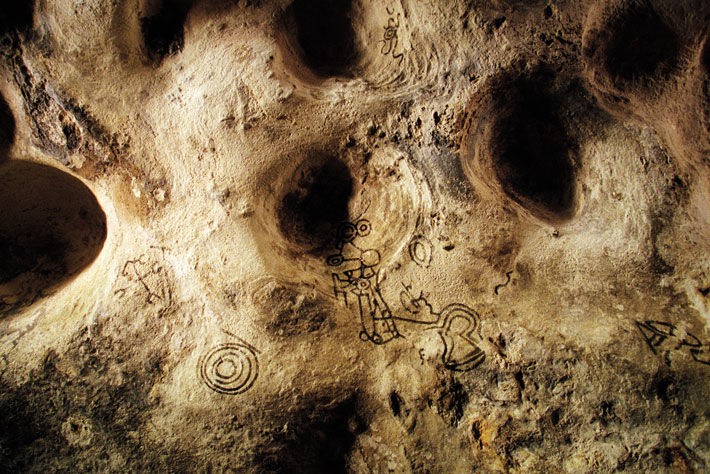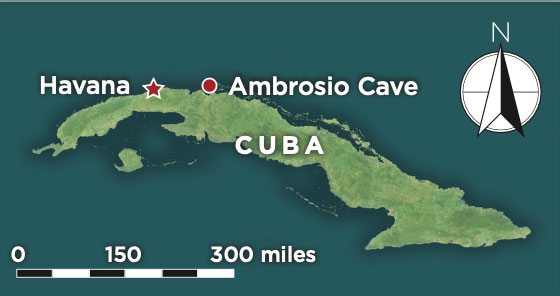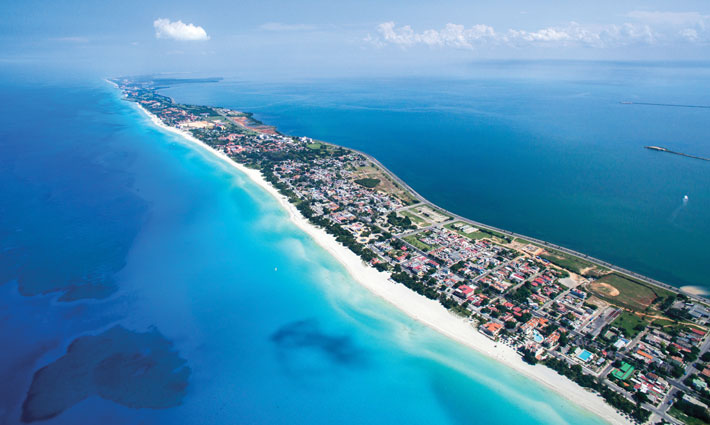Off the Grid: Ambrosio Cave, Cuba
January/February 2024
 Cueva de Ambrosio, or Ambrosio Cave, harbors more than 70 red-and-black drawings of geometric shapes as well as mythological and human figures scattered throughout its five interconnected galleries. The cave is located on a verdant strip toward the end of Hicacos Peninsula, on Cuba’s northern coast. It lies within Varahicacos Ecological Reserve, which ensures the protection of approximately one square mile of tropical landscape of Matanzas Province, two hours’ drive from Havana. The reserve, which was established in 1974, also contains Cueva de los Musulmanes, or Muslim Cave, a purported historic smugglers’ hideout.
Cueva de Ambrosio, or Ambrosio Cave, harbors more than 70 red-and-black drawings of geometric shapes as well as mythological and human figures scattered throughout its five interconnected galleries. The cave is located on a verdant strip toward the end of Hicacos Peninsula, on Cuba’s northern coast. It lies within Varahicacos Ecological Reserve, which ensures the protection of approximately one square mile of tropical landscape of Matanzas Province, two hours’ drive from Havana. The reserve, which was established in 1974, also contains Cueva de los Musulmanes, or Muslim Cave, a purported historic smugglers’ hideout.
 Illuminated by shafts of light filtering through holes in the cave’s ceiling, the pictographs share space with several species of bats, insects, and plants. The more than 200-foot-long limestone cave likely served as a ceremonial space at various times in the past, says archaeologist Racso Fernández Ortega of the Cuban Institute of Anthropology. Scholars believe the cave’s artworks, some of which may date to as long as 2,000 years ago, were drawn by Indigenous people before the arrival of Europeans in the fifteenth century, and later by people of African descent who had escaped enslavement. “Determining how old paintings are can be really difficult,” says chemist Ruth Ann Armitage of Eastern Michigan University, who specializes in radiocarbon dating of rock art. “Dating methods tell you how old the material is, not when a person did something with it. Anything that’s been restored, retouched, or publicly accessible is nearly impossible to date.”
Illuminated by shafts of light filtering through holes in the cave’s ceiling, the pictographs share space with several species of bats, insects, and plants. The more than 200-foot-long limestone cave likely served as a ceremonial space at various times in the past, says archaeologist Racso Fernández Ortega of the Cuban Institute of Anthropology. Scholars believe the cave’s artworks, some of which may date to as long as 2,000 years ago, were drawn by Indigenous people before the arrival of Europeans in the fifteenth century, and later by people of African descent who had escaped enslavement. “Determining how old paintings are can be really difficult,” says chemist Ruth Ann Armitage of Eastern Michigan University, who specializes in radiocarbon dating of rock art. “Dating methods tell you how old the material is, not when a person did something with it. Anything that’s been restored, retouched, or publicly accessible is nearly impossible to date.”
 The first people to land on the shores of the Caribbean archipelago likely came from places including the Yucatán Peninsula between 5000 and 4000 B.C. Cuba’s first settlers probably arrived between 4000 and 3000 B.C. It is unclear which Indigenous populations were living on the island when Christopher Columbus arrived in 1492, but scholars speculate that groups including the Guanahatabey, Ciboney, and Taíno coexisted there. Within a few decades, the dwindling Indigenous population had been all but wiped out through a combination of warfare with colonialists, forced labor, and disease introduced by the Spaniards. “Indigenous populations disappeared so fast that we’ll probably never know how many tribal groups there were,” says archaeologist Suzanne Baker of the firm Archaeological/Historical Consultants. “Rock art is an important material expression of the oral history and cosmology that was lost.”
The first people to land on the shores of the Caribbean archipelago likely came from places including the Yucatán Peninsula between 5000 and 4000 B.C. Cuba’s first settlers probably arrived between 4000 and 3000 B.C. It is unclear which Indigenous populations were living on the island when Christopher Columbus arrived in 1492, but scholars speculate that groups including the Guanahatabey, Ciboney, and Taíno coexisted there. Within a few decades, the dwindling Indigenous population had been all but wiped out through a combination of warfare with colonialists, forced labor, and disease introduced by the Spaniards. “Indigenous populations disappeared so fast that we’ll probably never know how many tribal groups there were,” says archaeologist Suzanne Baker of the firm Archaeological/Historical Consultants. “Rock art is an important material expression of the oral history and cosmology that was lost.”
THE SITE
Ambrosio Cave’s artworks were discovered in 1961 by archaeologists Manuel Rivero de la Calle and Mario Orlando Pariente Pérez, and the paintings were restored by archaeologist and revolutionary Antonio Núñez Jiménez in 1968. Since then, the identity of the artists who painted the cave walls and the meaning of the cave’s imagery have been the subjects of much scholarly speculation. Some archaeologists have suggested that Indigenous populations produced the more abstract shapes, while the more complex human and zoomorphic depictions may be later artworks created by people of African descent. Fernández Ortega believes some of the older renderings may represent the Taíno creation myth of the sun and the moon. Other interpretations suggest that the images could represent solar calendars, butterflies, or Indigenous peoples’ initial interactions with the Spanish.
WHILE YOU’RE THERE
From Havana, take a bus or hire a driver to reach the resort town of Varadero and the pristine beaches at the heart of a cluster of luxury hotels on the tip of the peninsula. There, you can ride the hop-on, hop-off bus and eat at one of the local restaurants. In the opposite direction, toward the city of Matanzas, you will find Cueva de Saturno, or Saturn Cave, which boasts a subterranean swimming hole with crystal waters and dramatic stalagmites and stalactites.
Advertisement
IN THIS ISSUE
Digs & Discoveries
When It Rains It Pours
A Courtesan’s Prized Possession
Maize Maintenance
Denmark’s Founding Mother
Tracking Ancient Animals
Ice Age Cannibalism
From Hunted to Herded
Divine Dreaming
Legionary Personal Effects
Portrait of an Ancient Ax
Off the Grid: Ambrosio Cave, Cuba
Artifact
Maya toy story
Advertisement

Recent Issues
-
 May/June 2024
May/June 2024
-
 March/April 2024
March/April 2024
-
 January/February 2024
January/February 2024
-
 November/December 2023
November/December 2023
-
 September/October 2023
September/October 2023
-
 July/August 2023
July/August 2023
-
 May/June 2023
May/June 2023
-
 March/April 2023
March/April 2023
-
 January/February 2023
January/February 2023
-
 November/December 2022
November/December 2022
-
 September/October 2022
September/October 2022
-
 July/August 2022
July/August 2022
-
 May/June 2022
May/June 2022
-
 March/April 2022
March/April 2022
-
 January/February 2022
January/February 2022
-
 November/December 2021
November/December 2021
-
 September/October 2021
September/October 2021
-
 July/August 2021
July/August 2021
-
 May/June 2021
May/June 2021
-
 March/April 2021
March/April 2021
-
 January/February 2021
January/February 2021
-
 November/December 2020
November/December 2020
-
 September/October 2020
September/October 2020
-
 July/August 2020
July/August 2020
-
 May/June 2020
May/June 2020
-
 March/April 2020
March/April 2020
-
 January/February 2020
January/February 2020
-
 November/December 2019
November/December 2019
-
 September/October 2019
September/October 2019
-
 July/August 2019
July/August 2019
-
 May/June 2019
May/June 2019
-
 March/April 2019
March/April 2019
-
 January/February 2019
January/February 2019
-
 November/December 2018
November/December 2018
-
 September/October 2018
September/October 2018
-
 July/August 2018
July/August 2018
-
 May/June 2018
May/June 2018
-
 March/April 2018
March/April 2018
-
 January/February 2018
January/February 2018
-
 November/December 2017
November/December 2017
-
 September/October 2017
September/October 2017
-
 July/August 2017
July/August 2017
-
 May/June 2017
May/June 2017
-
 March/April 2017
March/April 2017
-
 January/February 2017
January/February 2017
-
 November/December 2016
November/December 2016
-
 September/October 2016
September/October 2016
-
 July/August 2016
July/August 2016
-
 May/June 2016
May/June 2016
-
 March/April 2016
March/April 2016
-
 January/February 2016
January/February 2016
-
 November/December 2015
November/December 2015
-
 September/October 2015
September/October 2015
-
 July/August 2015
July/August 2015
-
 May/June 2015
May/June 2015
-
 March/April 2015
March/April 2015
-
 January/February 2015
January/February 2015
-
 November/December 2014
November/December 2014
-
 September/October 2014
September/October 2014
-
 July/August 2014
July/August 2014
-
 May/June 2014
May/June 2014
-
 March/April 2014
March/April 2014
-
 January/February 2014
January/February 2014
-
 November/December 2013
November/December 2013
-
 September/October 2013
September/October 2013
-
 July/August 2013
July/August 2013
-
 May/June 2013
May/June 2013
-
 March/April 2013
March/April 2013
-
 January/February 2013
January/February 2013
-
 November/December 2012
November/December 2012
-
 September/October 2012
September/October 2012
-
 July/August 2012
July/August 2012
-
 May/June 2012
May/June 2012
-
 March/April 2012
March/April 2012
-
 January/February 2012
January/February 2012
-
 November/December 2011
November/December 2011
-
 September/October 2011
September/October 2011
-
 July/August 2011
July/August 2011
-
 May/June 2011
May/June 2011
-
 March/April 2011
March/April 2011
-
 January/February 2011
January/February 2011
Advertisement





